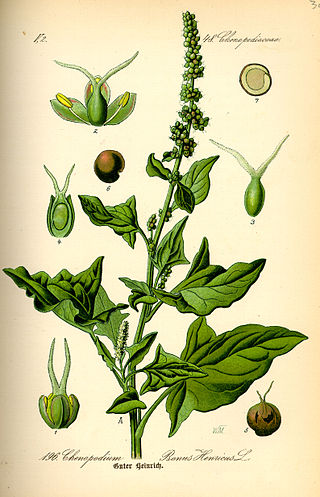
Nashia is a genus of flowering plant in the vervain family, Verbenaceae.

Blitum bonus-henricus, also called Good-King-Henry, poor-man's asparagus, perennial goosefoot, Lincolnshire spinach, Markery, English mercury, or mercury goosefoot, is a species of goosefoot which is native to much of central and southern Europe.

Carl Ludwig Willdenow was a German botanist, pharmacist, and plant taxonomist. He is considered one of the founders of phytogeography, the study of the geographic distribution of plants. Willdenow was also a mentor of Alexander von Humboldt, one of the earliest and best known phytogeographers. He also influenced Christian Konrad Sprengel, who pioneered the study of plant pollination and floral biology.

Pfeiffera is a genus of flowering plants in the family Cactaceae, found in Bolivia and northwest Argentina. There is some debate about the circumscription of the genus. It is in the Phyllocacteae tribe.

Haageocereus is a genus of cacti endemic to the lower elevations of the extremely dry desert along the coast of Peru and northern Chile.

Hanguana is a genus of flowering plants with a dozen known species. It is the only genus in the family Hanguanaceae.

Linderniaceae is a family of flowering plants in the order Lamiales, which consists of about 25 genera and 265 species occurring worldwide. Vandellia micrantha is eaten in Laos, but tastes bitter. Best known are the wishbone flowers Torenia fournieri and Torenia thouarsii, which are used as bedding plants, especially in the tropics. Micranthemum is sold as an aquarium plant when it is called 'baby tears'.
Metcalfia is a genus of plants in the grass family. It contains a single species, Metcalfia mexicana, native to Mexico.

Willdenowia: Annals of the Botanic Garden and Botanical Museum Berlin is a triannual peer-reviewed scientific journal on plant, algal, and fungal taxonomy published by the Botanic Garden and Botanical Museum Berlin, Freie Universität Berlin. It was established in 1895 as Notizblatt des Königlichen botanischen Gartens und Museums zu Berlin, and was renamed to the current title in 1954 to honour botanist Carl Ludwig Willdenow (1765-1812), director of the Royal Botanic Garden in Schöneberg near Berlin.

Chenopodiastrum is a genus of herbaceous flowering plants in the family Amaranthaceae. The genus was formally described in 2012. The 5 species occur in Eurasia, North Africa, and North America.
Hypodiscus is a group of plants in the Restionaceae named by Christian Gottfried Daniel Nees von Esenbeck and described as a genus in 1836.

The genus Lindernia is a group of plants in the family Linderniaceae. They are native to warm regions in both the Eastern and Western Hemisphere.
Bartsiella is a monotypic genus of flowering plants, initially classified in Scrophulariaceae, and now within the broomrape family Orobanchaceae. It contains a unique species, Bartsiella rameauana.

Psephellus is a genus of flowering plants in the family Asteraceae, native to eastern Europe and western Asia. A taxonomic revision reassigned many species from Centaurea to Psephellus.

Kimnachia is a monotypic genus of cacti. Its only species is Kimnachia ramulosa, synonym Pseudorhipsalis ramulosa, which is native from southern Mexico to northern South America and also found in Jamaica.
Ortegia is a monotypic genus of flowering plants belonging to the family Caryophyllaceae. It only contains one known species, Ortegia hispanicaL. It is part of the tribe Polycarpaeae, clustering with Cardionema and Illecebrum.
Isidroa is a monotypic genus of flowering plants belonging to the family Verbenaceae. The only species is Isidroa spinifera.
Kerriothyrsus is a monotypic genus of flowering plants belonging to the family Melastomataceae. The only species is Kerriothyrsus tetrandrus(Nayar) C.Hansen

Willdenowia incurvata is a species of flowering plant in the genus Willdenowia endemic to the Fynbos region of the Northern Cape and Western Cape. It is also known as the sonqua sunreed; or sonkwasriet in Afrikaans.














